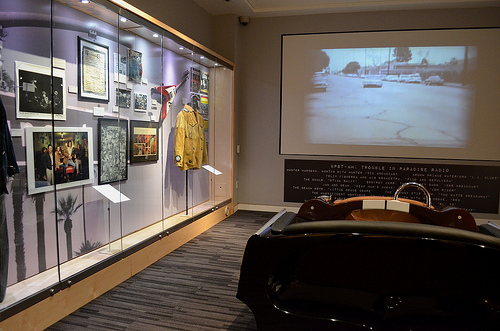“Trouble in Paradise: Music and Los Angeles 1945-1975” Exhibition Opens At The Grammy Museum

And while some aspects of a sugary surf culture did actually exist, so did a racially segregated society and a sometimes-brutal police force. The two often collided with turbulent results. In the new exhibition at the Grammy Museum, “Trouble in Paradise: Music and Los Angeles 1945-1975,” post-WWII social tensions, along with historically and musically significant social clashes are highlighted through video, photographs, text, recordings and musical relics, all to demonstrate that, quite often, periods of social unrest result in captivating music that invents, reinvents and pushes stylistic and lyrical boundaries.
Co-curated by Grammy Museum Executive Director Robert Santelli and USC Professor Josh Kun, the exhibition focuses on this particular 30-year period in Los Angeles history because it was full of enough transition and trial to lead to the creation of a bogglingly wide array of music. Los Angeles was then home to one of the most diverse music scenes the country has ever seen, during a time when immigrants and transplants were flooding the city to live out the post-war promises of the sunny, prosperous metropolis.
Iconic jazz, R&B, rock and roll and Chicano rock were created during those decades, much of it having to do with the social distresses of the period. In the mid 1960’s, the image of dreamy Los Angeles began to tarnish with news of the Watts Riots.
But in both creative and political response, organizers put on the Wattstax, often referred to as “The Black Woodstock,” a mega-concert featuring artists like The Staple Singers, The Bar-Kays and Isaac Hayes, held at the Los Angeles Coliseum.
In at least some ways, the event helped to reunited a community torn apart, focusing attention on the positive coming out of the area: meaningful, beautiful African American-made music. The “Sunset Strip riots” led to further popularity of bands like The Byrds, The Doors and Buffalo Springfield, the latter of which responded directly to the riots with the infamous “For What It’s Worth,” which became one of the more popular anti-war songs of the decade.
Because of the police brutality at the 1970 Chicano Anti-Vietnam rally, Chicano bands like Thee Midniters and Cannibal and the Headhunters became politically charged and were amongst the first Mexican-American bands to release national top hits—both bands unafraid to boldly tackle topics of racism and Chicano rights in song and spirit.
Footage of each of these events is included in the exhibition, along with clothing, instruments, records, photographs and the chance to listen to mentioned music. All of which details the good and the bad, the beautiful and the ugly of the time.
The overall experience of the exhibition could go a long way in either reminding or newly educating attendees of the practical power of music and the ways in which society and music have always depended upon one another.
Reach Reporter Emily here.



